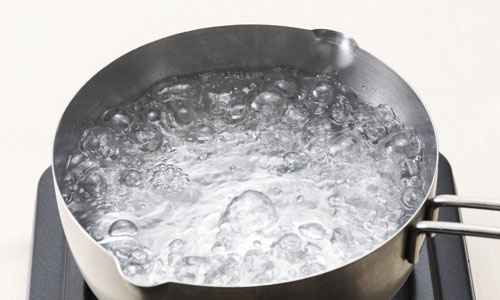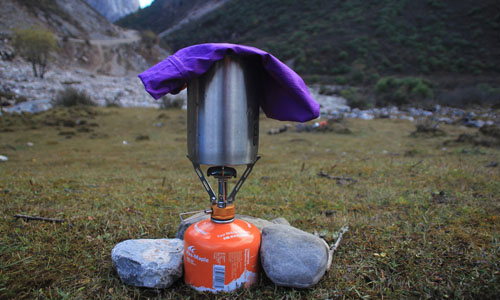Ways to Make Water Safe
Author

A keen runner, skier and nuts about cycling. Karl lives in Cumbria, where he loves encouraging his two children to follow in his outdoor lifestyle. Whilst out and about keeping active, Karl keeps a diary and shares it with Outdoor Look.
 One of the most important things you want to carry before you go hiking or trekking outdoors is water. Even though this naturally occurring gift is abundantly available, we cannot just use it the way we want. There is only a certain amount of fresh water available on Earth, that can be drunk without purifying it. So, before embarking on a journey outside, here are some useful tips as to how you can make water potable and safe enough to drink.
One of the most important things you want to carry before you go hiking or trekking outdoors is water. Even though this naturally occurring gift is abundantly available, we cannot just use it the way we want. There is only a certain amount of fresh water available on Earth, that can be drunk without purifying it. So, before embarking on a journey outside, here are some useful tips as to how you can make water potable and safe enough to drink.
Boiled Water
The most primitive way of purifying water is to boil it. This has been done since ancient times, and it does not require any special equipment. Boiling water is the simplest way by which it can be made safe enough to drink. All you need is a metal pot and a stove. According to scientists, just one minute is enough to kill a lot of the impurities in water. At higher altitudes, though, one needs to boil water for longer in order to ensure maximum purity - be sure to check the advice for boiling water at high altitudes, if this applies to your intended route.
 Using a Disinfectant
Using a Disinfectant
Certain disinfectants can cleanse water or purify it. Iodine or Chlorine are considered to be the best water disinfectants. A little bit of these can kill a lot of the harmful infectants in water. Chlorine and iodine can disinfect water by reducing the count of harmful impurities significantly. Also, the cloudy water needs to be strained properly after adding these solutions to it. This is a very effective way to purify water as it minimises the chances of waterborne diseases.
Filtering the Water
Filtering water can be yet another effective way to purify water to make it fit for drinking. Compact water filters are available to make water potable when you are outdoors. The compact water filters are easily available and are also very easy to carry around. The three common types are: gravity filters, pump filters, and squeeze filters.
Price of these filters vary, primarily based on micron rating, design, quality, etc. Before buying a filter, it would be wise to do a bit of research about the technical specifications to find out if it can remove all harmful pathogens or only a few of them. For instance, good water filters can do their work very quickly, and can remove around 99.96% of harmful bacteria as well as 99.9% of protozoa. But filters will not be effective in removing viruses from the water, so in order to ensure optimum purity of the water, it is wise to filter and boil the water before drinking it.
Author

A keen runner, skier and nuts about cycling. Karl lives in Cumbria, where he loves encouraging his two children to follow in his outdoor lifestyle. Whilst out and about keeping active, Karl keeps a diary and shares it with Outdoor Look.
Categories
- Sport (28)
- Product Reviews (3)
- Team Outdoor Look (7)
- Mike Wild (2)
- Mike Payton (2)
- Suse Hammond-Pears (3)
- Snowboarding (12)
- Latest Offers (105)
- Shop Talk (1)
- Competitions (7)
- Walking (413)
- Lifestyle Fashion (8)
- Travel (86)
- Kit Guides (176)
- Workwear Clothing (6)
- Safety Workwear (4)
- Health/Fitness (289)
- Skiing (91)
- Great Outdoors (1316)
- Cycling (92)
- January 2025
- December 2024
- November 2024
- October 2024
- September 2024
- August 2024
- July 2024
- June 2024
- May 2024
- April 2024
- March 2024
- February 2024
- January 2024
- December 2023
- November 2023
- October 2023
- September 2023
- August 2023
- July 2023
- June 2023
- May 2023
- April 2023
- March 2023
- February 2023
- January 2023
- December 2022
- November 2022
- October 2022
- September 2022
- August 2022
- July 2022
- June 2022
- May 2022
- April 2022
- March 2022
- February 2022
- January 2022
- December 2021
- November 2021
- October 2021
- September 2021
- August 2021
- July 2021
- June 2021
- May 2021
- April 2021
- March 2021
- February 2021
- January 2021
- December 2020
- November 2020
- October 2020
- September 2020
- August 2020
- July 2020
- June 2020
- May 2020
- April 2020
- March 2020
- February 2020
- January 2020
- December 2019
- November 2019
- October 2019
- September 2019
- August 2019
- July 2019
- June 2019
- May 2019
- April 2019
- March 2019
- February 2019
- January 2019
- December 2018
- November 2018
- October 2018
- September 2018
- August 2018
- July 2018
- June 2018
- May 2018
- April 2018
- March 2018
- February 2018
- January 2018
- December 2017
- November 2017
- October 2017
- September 2017
- August 2017
- July 2017
- June 2017
- May 2017
- April 2017
- March 2017
- February 2017
- January 2017
- December 2016
- November 2016
- October 2016
- September 2016
- August 2016
- July 2016
- June 2016
- May 2016
- April 2016
- March 2016
- February 2016
- January 2016
- December 2015
- November 2015
- October 2015
- September 2015
- August 2015
- July 2015
- June 2015
- May 2015
- April 2015
- March 2015
- February 2015
- January 2015
- December 2014
- November 2014
- October 2014
- September 2014
- August 2014
- July 2014
- June 2014
- May 2014
- April 2014
- March 2014
- February 2014
- January 2014
- December 2013
- November 2013
- October 2013
- September 2013
- August 2013
- July 2013
- June 2013
- May 2013
- April 2013
- March 2013
- February 2013
- January 2013
- December 2012
- November 2012
- October 2012
- September 2012
- August 2012
- July 2012
- June 2012
- May 2012
- April 2012
- March 2012
- February 2012
- January 2012
- December 2011
- November 2011
- October 2011
- September 2011
- August 2011
- May 2010
- April 2010
- March 2010
- February 2010
- January 2010
- November 2009
- October 2009
- September 2009
Submit a Comment